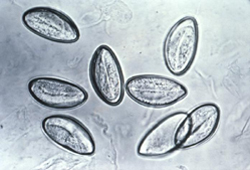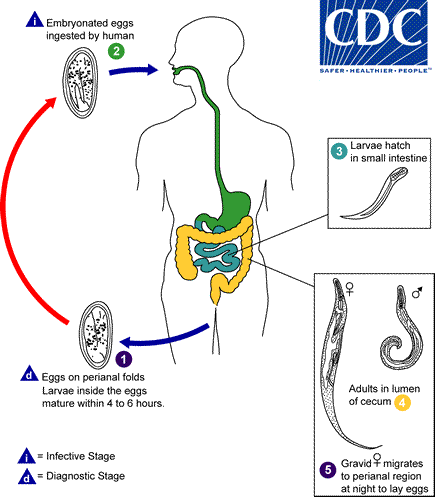Aetiology
The pinworm, otherwise known as Enterobius vermicularis, is a roundworm belonging to the nematode family. The entire life cycle is limited to humans, and there are no intermediate hosts. Infection occurs by ingesting infectious pinworm eggs.[1] Transmission of disease occurs via faecal-oral route (including auto-inoculation) either person-to-person by contaminated hands or sexual transmission or through contact with items contaminated with eggs such as food, clothing, or bedding.[1][15] Pinworm eggs can become airborne, suggesting inhalation from air and dust as another route of transmission.[16] Eggs can survive without a human host for up to 2 weeks indoors.[1]
[Figure caption and citation for the preceding image starts]: Pinworm eggImage provided by the CDC Public Health Image Library; used with permission [Citation ends].
Pathophysiology
Both male and female adult pinworms live in the colon and rectum. After copulation, gravid female worms migrate out of the anus at night and deposit up to 10,000 eggs on the perianal surface, where they embryonate within 6 hours.[14] This may cause local irritation, itching, and scratching, which contaminates the fingers. Eggs are then ingested by the same host or another individual.[1] Larvae hatch in the small intestine and migrate to the colon, where they mature and begin the cycle again. This entire life cycle takes approximately 2 to 6 weeks.[1]
Occasionally, eggs may hatch on the perianal area, and the larvae may migrate back into the colon, where they mature. There is no extraintestinal phase; therefore, signs of systemic infection such as fever and eosinophilia are uncommon.[11][Figure caption and citation for the preceding image starts]: Lifecycle of Enterobius vermicularisImage provided by the CDC Division of Parasitic Diseases and Malaria; used with permission [Citation ends].
Use of this content is subject to our disclaimer